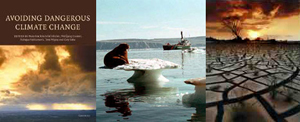The UK government has just published a book that synthesizes all of the scientific findings presented at the 2005 Avoiding Dangerous Climate Change†conference. Entitled “Avoiding Dangerous Climate Changeâ€, the book examines the real threat of global warming due to humanity and its future impacts. It focuses on three crucial questions:
1. For different levels of climate change what are the key impacts, for different regions and sectors, and for the world as a whole?
2. What would such levels of climate change imply in terms of greenhouse gas stabilisation concentrations and emission pathways required to achieve such levels?
3. What technological options are there for achieving stabilisation of greenhouse gases at different stabilisation concentrations in the atmosphere, taking into account costs and uncertainties?
Here is a short summary from Treehugger:
Currently, the atmosphere contains about 380 parts per million (ppm) of carbon dioxide, the greenhouse gas linked closest to climate change and the principal concern of scientists, compared to levels before the industrial revolution of about 275ppm. The European Union adopted a previous target of preventing a rise in global average temperature of more than two degrees Celsius, which, according to the book, might be too high — enough to trigger melting of the Greenland ice sheet. Above two degrees, says the report, the risks increase “very substantially”, with “potentially large numbers of extinctions” and “major increases in hunger and water shortage risks… particularly in developing countries”. The book concludes, therefore, that in order to have a good chance of achieving the EU’s two-degree target, levels need to be stabilized below 450 ppm.
In the foreword, Prime Minister Tony Blair writes: “It is now plain that the emission of greenhouse gases, associated with industrialisation and economic growth from a world population that has increased six-fold in 200 years, is causing global warming at a rate that is unsustainable.”
The book is free and available for download. For more information on what you can personally do, check out Green-E and TerraPass.
